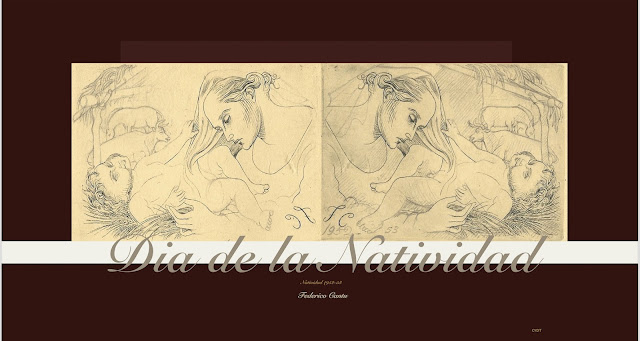Feliz Navidad
Federico Cantú 1907-1989
Natividad 1952-53
Grabado al buri
lColección de arte Cantú Y de Teresa
La Navidad (en latín nativitas, «nacimiento») es una de las festividades más importantes del cristianismo, junto con la Pascua de resurrección y Pentecostés. Esta solemnidad, que conmemora el nacimiento de Jesucristo en Belén, se celebra el 25 de diciembre en la Iglesia católica, en la Iglesia anglicana, en algunas comunidades protestantes y en la mayoría de las Iglesias ortodoxas. En algunas de estas tradiciones también el 24, la Nochebuena (en inglés, Christmas Eve; en alemán, Heiligabend o Heiliger Abend) y el 26 (Second day of Christmas, zweiter Weihnachtsfeiertag o Stephanstag) son partes importantes de la fiesta de Navidad.
Federico Cantú trabajo el tema de la natividad en diferentes versiones y épocas! , por ejemplo esta versión donde aparece la virgen y el niño en el pesebre fue concebida para placa de cobre grabada al buril en la navidad de 1952 , sin embargo fue finalizada en 53 ( como bien lo señala el trazo ) , en esta obra podemos observar la impresión en primer estado de la placa , asi como ejercicios de trazo a lápiz dentro de la impresión en papel .Animado por el tema sacro, Federico empezó a trabajar diferentes motivos sacros cada una de las navidades , ya en 1960 y terminados los vitrales de la capilla de los Misioneros de Guadalupe , decidió trasladar a grabado en placa de cobre la monumentalidad de 6 metros del pasaje de la natividad , terminando este buril, lo titulo “ Natividad en Tamaulipas” mismo del que preparo un tiraje especial para el empresario regiomontano Ing. Carlos Guajardo, que fuera el patrocinador de la serie de murales de la facultad de Filosofía y Letras de nuestra UANL.
Adolfo Cantú
Navidad de 2022








